
The national flag of Romania is a tricolour. The Constitution of Romania states that "The flag of Romania is tricolour; the colours are arranged vertically in the following order from the flagpole: blue, yellow, red". The flag has a width-length ratio of 2:3; the proportions, shades of colour as well as the flag protocol were established by law in 1994, and extended in 2001.

The national flag of the Russian Federation is a tricolour of three equal horizontal fields: white on the top, blue in the middle, and red on the bottom. It was first raised in 1696, as an ensign for merchant ships under the Tsardom of Russia.

The State flag of Oman consists of a horizontal tricolor of white, red and green with a vertical red stripe on the left that contains the national emblem of Oman.

The national flag of Kazakhstan, also called the Kazakh flag, was adopted on 4 June 1992, replacing the flag of the Kazakh Soviet Socialist Republic. The flag was designed by Shaken Niyazbekov.

The national flag of Tajikistan was adopted in November 1992, replacing the flag of the Tajik Soviet Socialist Republic of 1953. The flag is a horizontal tricolor of red, white and green, with a yellow crown surmounted by an arc of seven stars at the centre. It has a width ratio of 2:3:2. The tricolor preserves the choice of colors in the former Tajik Soviet flag, as well as the 1:2 proportions.

The flag of the Lithuanian SSR was first adopted by the Lithuanian SSR in 1918, which was a plain red flag. After Lithuanian SSR was established again in 1940, the flag was a red flag with the national name and a hammer and sickle in the upper canton. The flag in use from 1953 to 1988 was a red flag with the golden hammer and sickle and a gold-bordered red star in its upper canton with a white thin stripe and green thick band on the bottom.

The flag of the Moldavian Soviet Socialist Republic was adopted on 31 January 1952. The flag has three horizontal bands of red, green (1/4) and red, with a hammer and sickle in the canton. As defined by the Presidium of the Supreme Soviet of the Moldavian Soviet Socialist Republic on the flag description:
The national flag of the Moldavian Soviet Socialist Republic consists of a panel of red color with a green stripe in the middle of the whole flag length, with the image on top of the red part of the flag from the flagpole golden hammer and sickle above a five-pointed red star framed by gold border. The ratio of the flag's width to its length is 1:2 with the bandwidth of green to the width of the flag 1:4
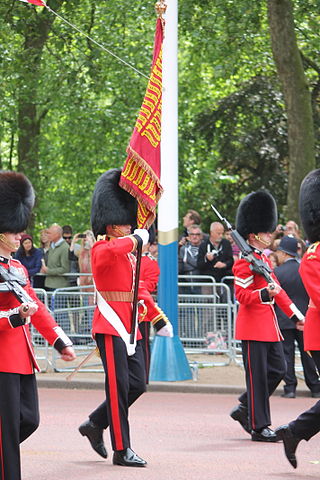
In military organizations, the practice of carrying colours, standards, flags, or guidons, both to act as a rallying point for troops and to mark the location of the commander, is thought to have originated in Ancient Egypt some 5,000 years ago. The Roman Empire also made battle standards, reading SPQR a part of their vast armies. It was formalized in the armies of Europe in the High Middle Ages, with standards being emblazoned with the commander's coat of arms.

The flag of the Republic of Sakha (Yakutia) (Yakut: Саха Өрөспүүбүлүкэтин былааҕа Saqa Öröspüübülüketin Bılaağa; Russian: Флаг Республики Саха (Якутия)), in the Russian Federation, is one of the official symbols of the Sakha Republic, alongside the coat of arms and the national anthem of the Sakha Republic. The flag has four horizontal stripes. From top to bottom, the stripes are light blue (3/4 of the flag's width), white (1/16), red (1/16), and green (1/8). The flag has been used officially as the flag of the Sakha Republic since 14 October 1992. The light blue stripe is charged with a white disc in the center. The diameter of the disc is 2/5 of the flag's width.

The flag of Crimea is the flag of the Autonomous Republic of Crimea in Ukraine and the Republic of Crimea controlled by Russia. The flag was officially adopted on 24 September 1992 as the flag of the Republic of Crimea, readopted on 21 April 1999, then readopted on 4 June 2014 as the flag of the Republic of Crimea, annexed by the Russian Federation.
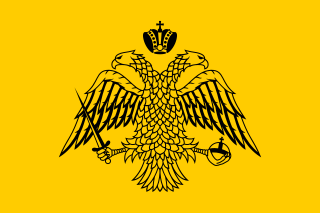
The Ecumenical Patriarchate and Mount Athos, and also the Greek Orthodox Churches in the diaspora under the Patriarchate use a black double-headed eagle in a yellow field as their flag or emblem.
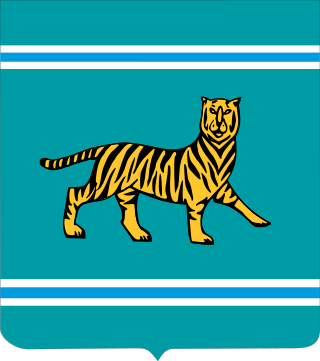
The coat of arms of the Jewish Autonomous Oblast is the official coat of arms of the Jewish Autonomous Oblast in Russia. The coat of arms consists of an Amur tiger standing on four legs with the tail and the head turned upwards, of which the latter is facing the observer. This specific position and occurrence of the Amur tiger in the coat of arms symbolizes the history and development of the Oblast. The coat is a heraldic French shield and the background represents the color of the geographical characteristics of the Russian Far East; which includes taigas, hills, and meadows.
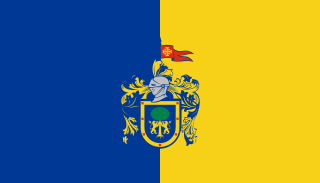
The flag of Jalisco was adopted in 2011. It is colored blue and gold and bears the State Emblem in the center. The emblem has a diameter of three-quarters the width of the stripes. The ratio of the flag is 4:7. Ribbons of the same colors may be placed at the foot of the finial. The flag is one of only three Mexican states that is not simply a coat of arms set against a white background, and it is the only one without any white at all.

The Flag of Novosibirsk Oblast is the official symbol of Novosibirsk Oblast, Russia.

The flag of the Lviv Region is one of regional flags of Ukraine. It is a symbol of the Lviv Oblast that inherits a historical tradition of using regional symbols and is an attribute of the local government and executive powers.
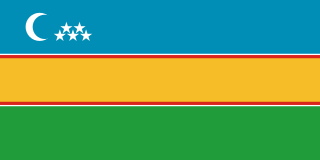
The flag of Karakalpakstan is one of the official symbols of Karakalpakstan, an autonomous republic within Uzbekistan. It was designed from a sketch by Karakalpak artist Zhollybai Izentaev. The flag is based on the flag of Uzbekistan.

The flag is the symbol of the Subcarpathian Voivodeship, Poland.

The civil flag of the Łódź Voivodeship, Poland is a rectangle divided into five vertical stripes, which are altering between red and yellow colours. It was designed by Marek Adamczewski, and officially adopted on 25 June 2002.

The flag that serves as the symbol of the historical and geographical region of the Western Pomerania is divided horizontally into two stripes: light blue on the top and white on the bottom. It originated as the flag of the Province of Pomerania, Prussia, used from 1882 to 1935. Since 1996, it is officially recognized as the symbol of the historical region of Western Pomerania within Mecklenburg–Western Pomerania, Germany.
The flag of Earth is a concept of a possible flag design meant to symbolize the planet Earth, humankind, or a possible world government.



















